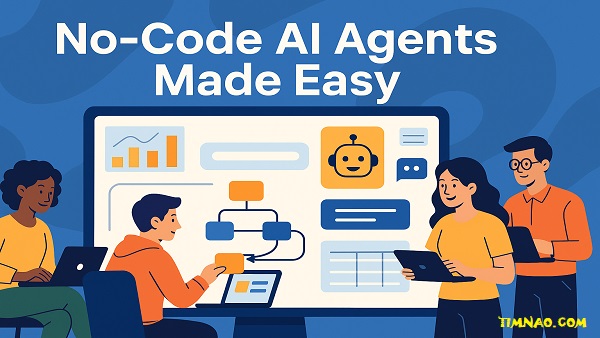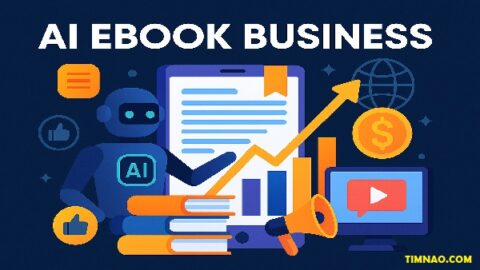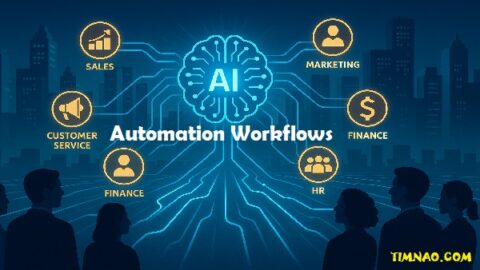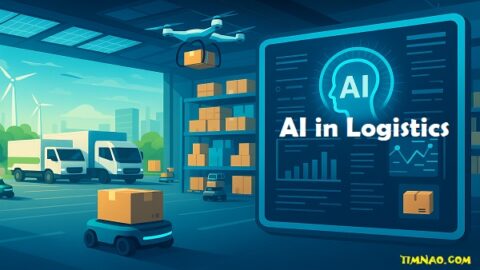Unleash Smart Innovation ⚡: The Hidden Power of No-Code AI Agents for Everyone
No-code AI agents are changing the game—making it possible for anyone, not just developers, to build powerful, intelligent systems without touching a single line of code. Whether you’re a small business owner, freelancer, teacher, or tech-curious beginner, these tools unlock a world of automation and smart problem-solving that was once reserved for software engineers.
In 2025, the rise of no-code platforms has made AI more accessible, intuitive, and affordable than ever before. With just a few clicks, you can create chatbots that reply to customers, virtual assistants that handle tasks, and smart apps that learn from data. And the best part? You don’t need any technical background to get started.
This guide is your step-by-step roadmap to understanding, building, and scaling no-code AI agents. You’ll learn what they are, how they work, the top tools to use, and how to apply them in real-world situations—even if you’ve never built anything before.
Ready to unlock your AI-building potential?
Let’s dive in. 👇
📚 Table of Contents
- 🚀 The Rise of No-Code AI: Why Now?
- 🧠 What Are No-Code AI Agents?
- 🎯 Real-World Use Cases You Can Start Today
- 🧰 Top No-Code Platforms to Explore in 2025
- 🛠️ How to Build Your First AI Agent (Step-by-Step)
- ⚡ Going Beyond Basics: Smart Features You Can Add
- 🔗 Seamless Integration: Connecting with Other Tools
- 📊 Measure, Improve, Repeat: Monitoring Your AI Agent
- 🧩 Ethics & Responsibility: Building Trustworthy AI
- 🌱 Scaling & Innovating for the Future
- 💡 Getting Started Today: Quick Tips for Beginners
- ❓ FAQs: Your Beginner Questions Answered
🚀 The Rise of No-Code AI Agents: Why Now?
In a world where technology evolves at breakneck speed, the ability to build smart systems without knowing how to code is nothing short of revolutionary. This is where no-code AI agents come into play—empowering everyday people to automate tasks, streamline operations, and create intelligent tools without writing a single line of code.
Until recently, building an AI system meant hiring expensive developers or learning complex programming languages. Now, thanks to powerful no-code platforms, even non-technical users can develop robust, intelligent applications. Whether you’re a solopreneur managing customer service or a teacher creating personalized learning tools, no-code automation makes it possible.
💡 Why now?
- The explosion of accessible tools like Zapier, Bubble, and Airtable
- Increased awareness of AI’s role in productivity
- A growing global community of creators building without code
- Lower barriers to entry for startups and individuals
In short, the playing field has never been more level. Innovation is no longer locked behind a wall of code.
🧠 What Are No-Code AI Agents?
Imagine having a digital assistant that automates emails, makes recommendations, or handles customer service—without needing a developer. That’s the promise of a no-code AI agent.
So, what exactly is it?
A no-code AI agent is a smart system created using drag-and-drop tools that can:
- Analyze data
- Make decisions
- Interact with users
- Learn and improve over time
These agents are powered by pre-built algorithms and machine learning models embedded within no-code platforms. You only need to define workflows and rules—it’s like giving your app a brain, without touching code.
Types of AI Agents You Can Build:
- Reactive agents: Respond to specific inputs (e.g., a chatbot replying to FAQs)
- Proactive agents: Take initiative based on user behavior (e.g., recommending products)
- Hybrid agents: Do both and adapt over time (e.g., smart assistants like Alexa)
They’re already being used in industries from healthcare to finance to education. And the best part? You can start building them today.
🎯 Real-World Use Cases You Can Start Today
Let’s explore how you can apply no-code AI agents in your life or business, even as a beginner.
1. Small Business Automation
A local bakery uses a no-code AI agent to handle online orders, respond to common customer questions, and send promotions based on customer behavior. This boosts engagement and frees up time.
2. Personal Finance Assistant
A budgeting app like Tiller allows users to automate expense categorization and savings goals using AI logic—all built on a no-code interface connected to Google Sheets.
3. E-commerce Recommendations
Using tools like Shopify Flow, store owners create smart workflows that recommend products based on past purchases, boosting upsells.
4. HR Recruitment Bot
A no-code agent screens resumes and schedules interviews using platforms like Tidio or Landbot, saving hours of manual work.
5. Virtual Health Checker
Glide apps allow clinics to build mobile-friendly health survey tools that recommend whether a patient needs to schedule a visit—no developer required.
Even if you’re just getting started, these examples show how AI without coding can be a real game-changer in everyday scenarios.
🧰 Top No-Code Platforms to Explore in 2025
The no-code movement is booming, and 2025 brings an impressive lineup of platforms that make building no-code AI agents easier, faster, and more powerful than ever. Whether you’re an entrepreneur, teacher, freelancer, or hobbyist, there’s a platform that suits your goals.
Here are some top tools that are beginner-friendly and packed with AI capabilities:
🔹 1. Bubble – Visual Web App Builder with Backend Logic
- Perfect for: Web apps with workflows, dynamic pages, and APIs.
- Features: Drag-and-drop UI builder, integrated database, and AI plugin marketplace.
- AI Use Case: Create a CRM that uses AI to prioritize leads based on behavior.
🔹 2. Zapier – Workflow Automation with AI Integration
- Perfect for: Connecting apps and automating repetitive tasks.
- Features: 6000+ integrations, “Zap” editor for triggers/actions, OpenAI plugin support.
- AI Use Case: Automatically summarize emails using ChatGPT and send to Slack.
🔹 3. Glide – No-Code Mobile Apps from Spreadsheets
- Perfect for: Mobile apps powered by Google Sheets or Airtable.
- Features: Simple logic rules, AI modules, and custom action triggers.
- AI Use Case: Build an appointment assistant that texts reminders and reschedules.
🔹 4. Make (formerly Integromat) – Visual Automation and AI Agents
- Perfect for: Complex multi-app workflows.
- Features: Detailed scenario builder, JSON & HTTP support, OpenAI integrations.
- AI Use Case: Create an AI-driven workflow that collects survey data, summarizes it with GPT, and emails reports to stakeholders.
🔹 5. Peltarion – No-Code Deep Learning Platform
- Perfect for: Training and deploying machine learning models.
- Features: End-to-end model lifecycle without code.
- AI Use Case: Build and deploy a model to predict customer churn based on behavior data.
Bonus: Tools with Built-In AI Models
- Notion AI – Smart writing and summarizing inside Notion docs.
- ChatGPT (via API) – Add conversational agents to any app.
- Adalo – No-code mobile app builder with logic components.
💡Pro Tip: Start simple. Pick a platform that matches your comfort level and gradually add features as you learn.
🛠️ How to Build Your First AI Agent (Step-by-Step)
Feeling inspired? Let’s walk through building your first AI agent using a no-code platform. We’ll use Make (formerly Integromat) and ChatGPT API in this beginner-friendly example to create an agent that automatically replies to customer inquiries.
🎯 Goal:
Build a no-code AI agent that reads new emails and replies with a personalized response using AI.
🔧 Step 1: Define the Problem
Think about what task your agent should perform. In our case:
“Respond to customer support emails using ChatGPT-generated replies.”
🧱 Step 2: Set Up Your Tools
You’ll need:
- A Make account
- A Gmail or Outlook account
- An OpenAI API key from platform.openai.com
🔗 Step 3: Create Your Scenario in Make
- Log in to Make
- Click “Create a New Scenario”
- Add a Gmail module → Choose “Watch Emails”
(This will trigger the agent when a new email arrives) - Add an OpenAI module → Choose “Create Completion”
(Insert the subject/body of the email as a prompt)
✉️ Step 4: Write the Prompt for ChatGPT
Use a custom prompt like:
“You are a customer support agent. Write a polite and helpful reply to this email: {{Email Body}}”
This allows GPT to generate a human-like response tailored to the user’s message.
📤 Step 5: Add a Gmail “Send Email” Module
- Use the response from ChatGPT as the body of the email.
- Set the “To” field to the original sender’s email address.
- Optionally, add personalization like their name or issue summary.
🚦 Step 6: Test and Activate
- Send yourself a test email.
- Run the scenario.
- Confirm that your AI agent read the message and sent a smart reply.
🎉 Congratulations—you’ve built your first AI agent without writing a line of code!
🔁 Bonus Tips
- Add filters to respond only to emails with certain keywords.
- Log outputs to Google Sheets for auditing.
- Add a feedback loop to track responses marked as “helpful” by customers.
👶 For Beginners: Start Here
- Try a Glide app that sends automatic reminders based on a spreadsheet.
- Use Zapier to summarize Slack threads using ChatGPT.
- Use Notion AI to clean up meeting notes and auto-tag tasks.
Every great system starts with one small, well-built agent. Once you build one, it becomes easier—and addictive!
⚡ Going Beyond Basics: Smart Features You Can Add
Once you’ve built your first no-code AI agent, the next step is to make it smarter and more useful. Just like upgrading from a basic phone to a smartphone, adding advanced features transforms your AI agent from functional to fantastic.
🧠 1. Add Natural Language Understanding (NLU)
Most basic agents only respond to predefined commands. With natural language processing (NLP), your agent can understand varied, human-like language and even detect intent.
✅ Try this:
- Use Dialogflow or Microsoft Power Virtual Agents to build agents that understand and respond based on user intent—not just keywords.
🔍 Example: Instead of replying only to “Cancel my subscription,” your agent can also understand “I want to stop paying monthly” or “How do I unsubscribe?”
🔄 2. Add Memory with Context Awareness
Basic AI agents react in the moment. Smart ones remember past conversations or user choices.
✅ How to add it:
- Use tools like Landbot with built-in variables to store answers.
- Use Airtable or Google Sheets as lightweight databases to “remember” user history.
📌 Example: A travel chatbot that remembers your preferred destinations or seating preferences for future queries.
🔍 3. Integrate Smart Search
Allow your AI agent to perform web searches or internal database lookups using APIs.
✅ You can:
- Connect SerpAPI for Google Search functionality.
- Build internal search using Algolia or Meilisearch.
🎯 Use Case: A virtual assistant for real estate that fetches the latest listings based on your criteria.
📸 4. Add Image Recognition
You don’t have to stick to text—no-code AI agents can recognize and interpret images, too.
✅ Try this:
- Use Peltarion or Roboflow for drag-and-drop computer vision models.
- Connect to OpenAI’s GPT-4 Vision model via API to analyze image content.
📌 Use Case: An app that helps field inspectors upload photos and get instant AI-generated damage assessments.
🔎 5. Enable Predictive Analytics
Want your agent to not just react, but predict outcomes? You can easily add predictive modeling to your no-code stack.
✅ Try:
- Obviously.AI – upload data, get predictions with zero code.
- MonkeyLearn – build classifiers and extract topics from unstructured data.
📈 Use Case: Predict customer churn based on behavior patterns, then trigger automated actions (like sending retention offers).
🗣 6. Multi-Channel Communication
Let your agent talk across multiple platforms—email, SMS, chat, even voice!
✅ Use tools like:
- Twilio Studio for SMS and voice bots.
- ManyChat for Facebook Messenger + Instagram DMs.
- Tidio or MobileMonkey for omnichannel bots.
📲 Example: An AI agent that texts reminders, answers Messenger queries, and emails follow-ups—all based on one action.
🔗 Seamless Integration: Connecting with Other Tools
One of the biggest advantages of building no-code AI agents is how easily they integrate with the tools you already use. Whether it’s Google Sheets, Slack, Shopify, or Stripe, you can create AI-powered workflows that work across your tech stack—no developer needed.
Here’s how to make it happen:
🔌 1. Use Zapier or Make to Connect Everything
Think of Zapier and Make as universal plugboards. They allow your AI agent to trigger or respond to actions in thousands of other apps.
✅ Example Zaps/Scenarios:
- New lead in Typeform → Use ChatGPT to write a follow-up email → Send via Gmail
- Support ticket in HelpScout → Summarize with OpenAI → Post to Slack
💡 Pro Tip: Use filters, paths, and conditional logic in Make for smarter branching.
📁 2. Share Data Across Platforms
Use spreadsheets or low-code databases like:
- Google Sheets (universal and easy)
- Airtable (visually powerful + great for team collaboration)
- Notion (great for structured content and smart wikis)
🧠 Smart agents can pull from and write to these databases—ideal for inventory, CRM, or project management bots.
🔄 3. Enable Real-Time Triggers
Use webhooks to power real-time reactions.
✅ Example:
- Customer submits a form on your website
→ A webhook sends the data to Make
→ GPT summarizes the request and updates your CRM
→ A Slack alert is triggered
Platforms like Bubble, Softr, or Glide support webhooks and HTTP modules without needing coding knowledge.
🧰 4. Combine Multiple APIs for Power Features
Stack tools together:
- AI (OpenAI, Claude, HuggingFace)
- Search (Algolia, Google)
- Payments (Stripe)
- Forms (Typeform, Jotform)
- Analytics (Mixpanel, Amplitude)
📌 Example:
Build a concierge bot that collects travel preferences in Typeform → creates a Google Sheet entry → uses GPT to generate a travel plan → emails the PDF using SendGrid.
🌐 5. Public Integrations & Community Templates
You don’t have to start from scratch. Platforms like:
- Zapier’s Shared Zaps
- Make Templates
- Glide App Store
- Notion Template Gallery
…offer thousands of plug-and-play integrations already built by others. Start with one, then modify it to your needs.
📊 Measure, Improve, Repeat: Monitoring Your AI Agent
Once your no-code AI agent is live, the work isn’t over—it’s just beginning. Smart builders know that the key to long-term success is constant iteration. That means measuring performance, learning from results, and improving your agent over time.
Here’s how to make sure your agent doesn’t just run—but thrives.
🔍 1. Start with Clear KPIs (Key Performance Indicators)
Before monitoring anything, define what “success” looks like. Common KPIs for no-code AI agents include:
- Response accuracy rate
- User satisfaction (via ratings or feedback)
- Task completion rate (e.g., how often the agent solves the user’s issue)
- Time saved per interaction
- Conversion rate or sales generated
✅ Example: If you built a lead qualification chatbot, your KPI might be the number of qualified leads per week it generates.
📈 2. Set Up Dashboards
You don’t need to be a data scientist to build dashboards. Use tools like:
- Google Sheets + Google Data Studio – for free, visual reporting.
- Airtable Interfaces – visual dashboards for your base.
- Notion Dashboards – track AI agent performance within your workspace.
💡 Pro Tip: Use Zapier or Make to automatically log data like “user question,” “agent response,” and “feedback score” into a spreadsheet.
🧪 3. Build Feedback Loops
Feedback is how your AI gets better. Ask users directly:
- “Was this answer helpful?”
- “Rate your experience from 1–5”
- “What could we have done better?”
✅ Implementation:
- Use Google Forms or Typeform after interactions.
- Store responses and retrain your AI agent (manually or with AI learning tools like Obviously.AI or Peltarion).
📌 Use Case: A support bot that starts recommending better articles after being trained on which previous answers were rated highly.
🧠 4. A/B Test Agent Behavior
Just like you would test landing pages, you can test multiple versions of your AI agent’s responses.
How:
- Test different prompts in ChatGPT modules (e.g., tone: friendly vs. professional).
- Try different workflows: short answers vs. detailed guides.
- Use randomizer modules in Make or branching logic in tools like Landbot.
💥 Insight: Small changes in language or timing can lead to big jumps in user satisfaction.
🧰 5. Monitor Errors and Drop-Offs
Not every user journey will be smooth. You need to track:
- Where users drop off or abandon sessions
- Error messages (e.g., “I don’t understand” responses)
- API call failures or timeouts
✅ Use built-in monitoring tools:
- Make: Error logs and visual indicators
- Bubble: Backend workflow debugger
- Glide: Action analytics per screen
The goal: Patch weak points before they affect too many users.
🔁 6. Continuously Iterate Based on Data
Schedule regular check-ins (weekly or monthly) to:
- Review analytics
- Examine user feedback
- Optimize flows
- Update prompts
- Re-train models (if using custom AI)
📅 Use tools like Trello or ClickUp to track improvements over time.
👩🔧 Treat your AI agent like a team member. Train it. Review it. Improve it.
🧩 Ethics & Responsibility: Building Trustworthy AI
Building AI—no matter how simple or no-code—comes with a responsibility. Just because you can automate something doesn’t mean you should do it without consideration for the ethics, transparency, and fairness of the system you’re creating.
This is especially important for beginners, because responsible design habits should start from day one.
🛑 1. Avoid Bias in Training Data
AI agents can unintentionally reflect bias in the data they’re trained on or connected to.
✅ Tips to avoid bias:
- Don’t rely on only one source of data.
- Regularly review AI responses for fairness and appropriateness.
- If collecting user data, ensure your sample includes diverse perspectives.
📌 Example: If an AI resume screener was trained on historical hiring patterns, it could inherit past discrimination—without you realizing.
🔒 2. Prioritize Privacy and Consent
Your no-code AI agent may collect names, emails, messages—or even behavioral data. You must handle this information securely and ethically.
✅ Best Practices:
- Add privacy disclaimers to your apps and chatbots.
- Clearly ask for consent when storing or processing user data.
- Use platforms that are GDPR and CCPA compliant (e.g., Airtable, Tally, Typeform).
💡 Tools like OneTrust can help you automate compliance for larger projects.
🧠 3. Be Transparent with Users
Let users know when they’re interacting with a bot, not a human. Transparency builds trust and sets realistic expectations.
✅ Example:
- Add a greeting like “Hi, I’m an AI assistant here to help you!”
- Provide the option to talk to a human if needed.
- Label AI-generated content (e.g., “Written by AI” at the bottom of blog posts).
This helps avoid confusion—and potential backlash—if something goes wrong.
⚖️ 4. Keep a Human in the Loop
No-code AI agents are great, but they shouldn’t replace humans in high-impact decisions like hiring, health advice, or financial recommendations.
✅ If your bot deals with serious tasks:
- Let it assist, not decide.
- Always offer an option to escalate to a human.
- Audit your bot’s decisions regularly.
📌 Rule of thumb: If the outcome can significantly affect someone’s life, don’t leave it fully to automation.
🧪 5. Test for Ethical “Edge Cases”
Think like a user. What happens if someone:
- Submits sensitive info?
- Abuses your agent?
- Enters offensive language?
✅ Your agent should:
- Avoid echoing inappropriate inputs.
- Know how to gracefully decline or redirect.
- Sanitize inputs and outputs where possible.
AI agents don’t have morals—but you do. Make sure your systems reflect your values.
🌱 Scaling & Innovating for the Future
Once you’ve built and fine-tuned your first no-code AI agent, you’ll naturally start thinking: “What’s next?”
The future belongs to those who scale wisely, experiment boldly, and keep innovating—even without code. Here’s how to grow from a single smart system to a fleet of AI-powered solutions that drive serious impact.
📈 1. Scale Your Agent for More Users
If your chatbot or app starts gaining traction, be ready to scale:
- Use platforms like Bubble and Adalo that offer auto-scaling plans.
- Migrate your database to scalable cloud platforms like Firebase or Airtable Pro.
- Implement caching or load balancing if handling large datasets or real-time users.
🧠 Tip: Monitor usage analytics to identify slowdowns or user drop-offs before they impact performance.
🔄 2. Clone and Customize for New Use Cases
The beauty of no-code tools? You can duplicate and tweak your AI agent to serve different teams, clients, or niches.
📌 Examples:
- Adapt your customer support chatbot for HR onboarding.
- Clone your finance budgeting assistant for freelancers, startups, and families.
- Localize your tool with different languages using NLP translation APIs like DeepL or Google Translate.
💡 Reusability is your superpower—build once, adapt endlessly.
🧠 3. Explore New Technologies as They Emerge
The no-code ecosystem evolves fast. Here are exciting trends to watch:
- Generative AI + No-Code: Create video, music, and designs with tools like Runway or Kaiber.
- AI + IoT: Connect AI agents to physical devices (e.g., smart thermostats or motion sensors).
- Voice Agents: Use Twilio Studio or Amazon Lex to build voice-activated agents.
🌍 The future of no-code is multi-modal, multi-platform, and fully intelligent.
🧠 4. Create a Culture of Innovation
If you’re working in a team or business, help others adopt no-code tools too:
- Host internal workshops or demo days.
- Set up a “no-code lab” for testing ideas.
- Encourage non-tech teammates to build their own agents.
🎯 Pro Tip: Innovation isn’t just about tools—it’s about mindset. No-code lets everyone participate.
💡 Getting Started Today: Quick Tips for Beginners
Feeling inspired but unsure where to begin? Here’s a step-by-step beginner’s cheat sheet to get started with no-code AI—today.
✅ 1. Choose One Simple Use Case
Don’t try to automate everything at once. Pick one narrow problem.
📌 Examples:
- “Reply to common emails”
- “Send reminders for upcoming bookings”
- “Summarize client feedback into a report”
Start small. Start smart.
🛠 2. Pick a Beginner-Friendly Platform
Try these to begin:
- Make – For AI workflows and automations
- Glide – For mobile apps powered by Google Sheets
- Zapier – For plug-and-play automation
- ChatGPT + Forms – For AI responses via Typeform or Tally
💬 Pro Tip: Use platform templates so you don’t start from scratch.
✏️ 3. Write a Good Prompt (Your Agent’s Brain)
Prompting is everything. Tell the AI what to do, how to act, and who it’s helping.
🧠 Prompt Starter:
“You are a helpful virtual assistant that responds to customer questions in a friendly and concise way. Use the message below and write a polite reply.”
📤 4. Launch & Learn Immediately
Get it live—even if it’s rough. Test it with yourself, your friends, or a few real users.
Watch how people interact. Then improve. You’ll learn more by shipping than by planning.
🧪 5. Don’t Be Afraid to Break Things
The magic of no-code is how fast you can fix, test, or roll back anything.
💡 Mistakes are just features waiting to be optimized.
❓ FAQs: Your Beginner Questions Answered
Here are some of the most common questions beginners ask—and clear, honest answers to help you move forward with confidence.
Q1: Do I need coding skills to build AI agents?
Nope. All the tools we mentioned are drag-and-drop and beginner-friendly. If you can use Google Docs or Excel, you can use tools like Make, Glide, or Zapier.
Q2: Isn’t AI complicated and expensive?
Not anymore. Many no-code tools now offer freemium plans and integrate with affordable APIs like ChatGPT. For $20–50/month, you can build advanced systems previously worth thousands.
Q3: How do I train my AI agent?
You don’t need to “train” it like a developer would. Instead, use:
- Carefully written prompts (for GPT-based agents)
- Structured data from spreadsheets or forms
- Feedback loops for improvement over time
Q4: Can I build apps with AI features?
Yes! You can create full-fledged mobile/web apps with AI smarts:
- Use Bubble or Adalo for design
- Add ChatGPT via plugin/API
- Store and retrieve data with Airtable or Sheets
Q5: How can I make sure my agent is ethical?
Follow 3 golden rules:
- Be transparent (label AI usage)
- Get consent when collecting data
- Avoid bias (review and improve based on feedback)
The earlier you build ethical habits, the better your projects will be long-term.
Reference video:









